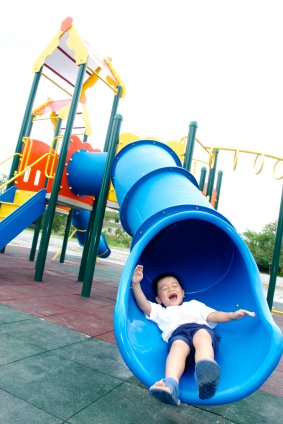The playground is a bittersweet place. On the playground children grow and develop interaction skills, but they can also become severely injured or worse. Here are a few things parents and others can do to help prevent children from being injured on the playground...
 by Alan Hammond
by Alan Hammond
The playground is a bittersweet place. On the playground children grow and develop interaction skills, but they can also become severely injured or worse. According to the Centers for Disease Control (CDC), more than 200,000 children 14 years of age and younger are treated in hospital emergency rooms across the United States. Most accidents, nearly 70 percent, occur on public playgrounds. They are usually associated with climbing equipment, slides and swings. More than one-third of all playground injuries are severe, with children incurring fractures, internal injuries, concussions, dislocations and amputations. Approximately 15 children die each year from those injuries, about half of which are from strangulation and one-quarter from falls from equipment. (Centers for Disease Control, Injury Fact Book, 2001-2002) Are you scared yet?
If you answered yes, don’t worry just yet. There are several things parents and others can do to help prevent children from being injured on the playground.
Check the child’s clothing. Their clothing can become entangled in the equipment and may result in strangulation or some other injury. Remove any and all drawstrings or use clothing that does not require a drawstring. When the weather would normally require a scarf, choose another form of neck warmer in order to prevent the loose flailing of the scarf. In short, any thing loose that can become tangled should be considered for use in the closet. Also, according to some physicians, parents often have their children wear helmets while on playground equipment. This can be more of a danger than a preventive measure, as the helmet straps can become entangled and lead to strangulation.
Choose the right playground. If your children are preschoolers, there are playgrounds or sections of playgrounds made especially for them. These have smaller, safer equipment requiring less coordination from children. Conversely, older children should not play in these areas primarily because of the danger they pose to the smaller children. Choose playgrounds that do not have hard, unforgiving surfaces. Ensure the surface is sufficiently covered with items such as sand, wood chips, synthetic chipped-rubber, or pea gravel. These surfaces and others like them are more forgiving, which exponentially reduces the risk of serious injury. Also, make sure the surface is consistent throughout the playground. The coverage depth of the surface should be around six to eight inches for the preschool playground and 12 to 14 inches on the main playground surface. Should you notice any areas of concern, notify the agency (municipal government, school, neighborhood association) responsible for maintenance. Follow-up and ensure that your concerns are addressed.
Supervision. Although not confirmed by statistics, inadequate adult supervision is the likely culprit in many accident cases. All children under the age of five should have constant adult supervision while on the playground. Children of that age are prone to falls and they often don’t have a healthy fear of too many things, which is a recipe for catastrophe. Older children also require supervision. They too become injured and, as younger children are also nearby or using the same equipment (although they should not be), could pose a danger to smaller children.
Alan Hammond is a criminal justice professional, writer and former educator. He can be reached in care of this publication or at ashwriting@insightbb.com.
No part of this article may be copied or reproduced in any form without the express permission of More4Kids Inc © 2008 All Rights Reserved
 by Alan Hammond
by Alan Hammond 









Add Comment